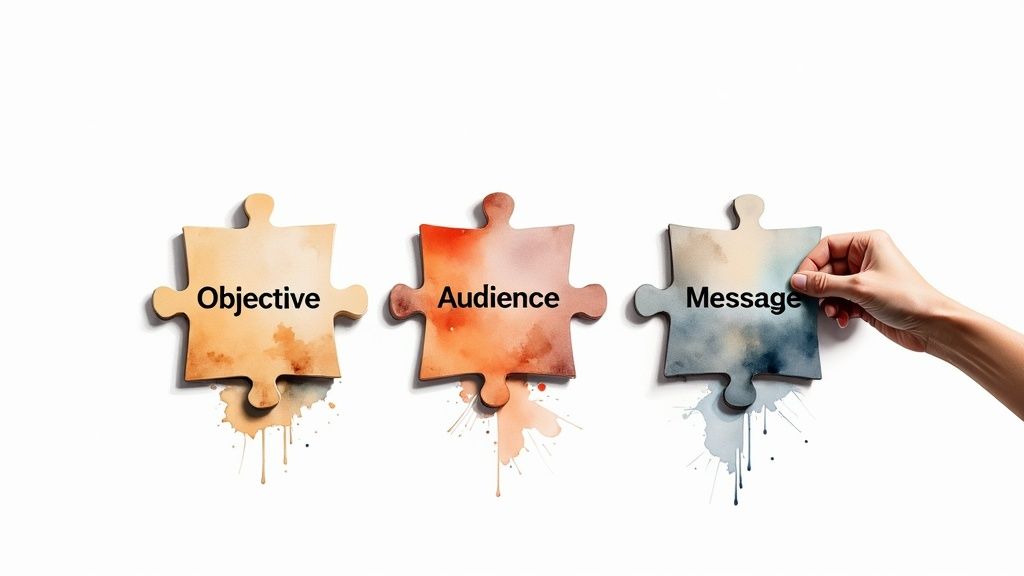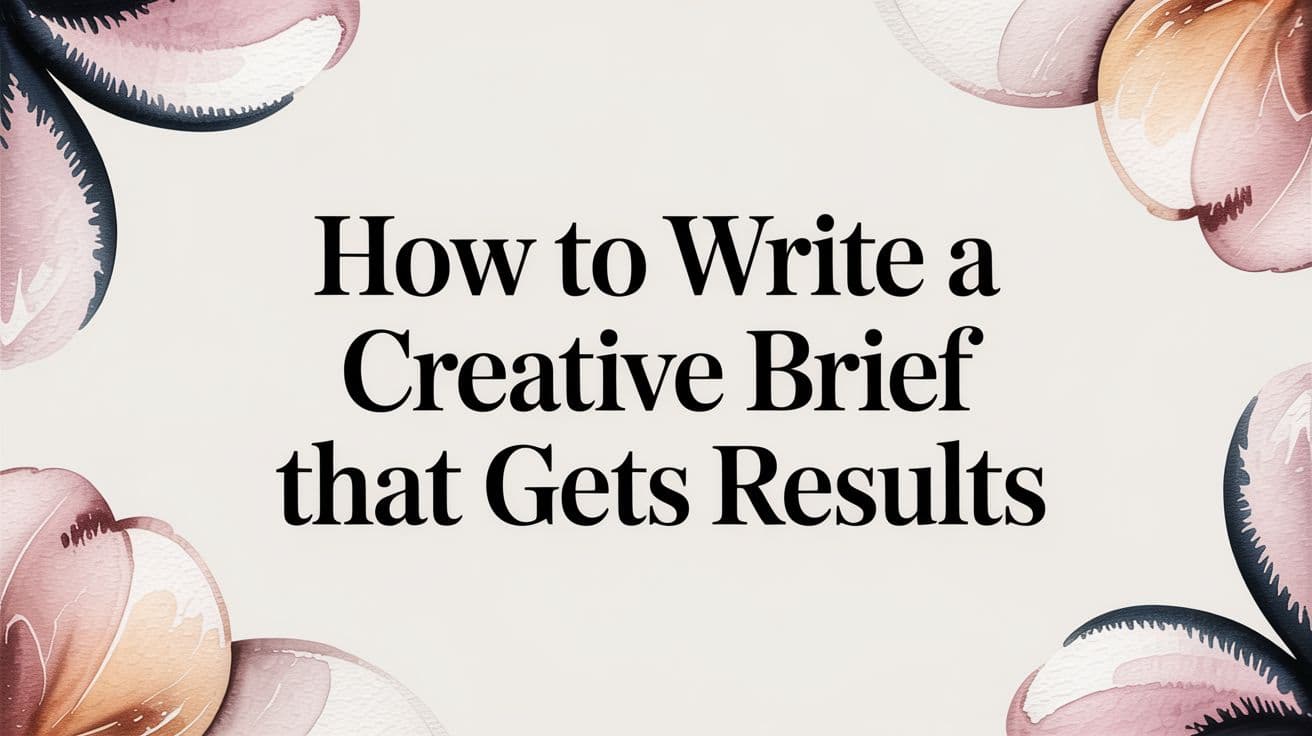A solid creative brief is your project’s roadmap. It’s a concise document that clearly lays out your goals, audience, and key message, giving your creative team the strategic direction they need to hit the mark.
The Strategic Power of a Great Creative Brief

Let's get one thing straight: a creative brief isn't just another piece of project paperwork. It's the strategic backbone of your entire campaign. I've seen more projects go off the rails due to a weak, ambiguous, or nonexistent brief than for any other reason. It truly is the single most critical factor for success.
A sharp, insightful brief acts as your north star. It reframes subjective feedback like, "I'm just not feeling it," into objective, strategic conversations: "Does this creative solve the problem we outlined for our target audience?" This shift is crucial for keeping projects on track, on budget, and on strategy.
Preventing Chaos and Inspiring Creativity
Without a clear brief, your creative team is essentially flying blind. That guesswork leads to a death spiral of endless revisions, wasted hours, and mounting frustration on all sides. The brief is your best defense against this kind of costly chaos because it establishes a single source of truth from day one.
But a great brief does more than just instruct—it inspires. When you provide deep audience insights and a crystal-clear problem to solve, you give your creatives the raw material they need to build something genuinely powerful and effective.
"A tight brief is the truest form of creative freedom. It provides the sandbox for the creative team to play in. The walls of the sandbox are the constraints, but inside, the team is free to build magnificent castles."
The data doesn't lie. A survey of over 900 executives found that a clear creative brief was rated the number one enabler of successful campaigns by 82% of clients and 79% of agencies. On the flip side, poor briefs were named the top reason for ineffective creative work.
Connecting the Brief to Broader Goals
A creative brief should never exist in a silo. It's a direct-line extension of your company's bigger business objectives. To see how it fits into the grand scheme, it helps to have a handle on developing a robust marketing strategy. The brief is what translates that high-level strategy into an actionable plan for a specific creative project.
Ultimately, the time you invest upfront in a thoughtful brief pays off in spades. It helps you by:
- Aligning Stakeholders: Gets everyone, from the CEO to the copywriter, rowing in the same direction.
- Saving Time and Money: Slashes the need for those soul-crushing, budget-draining revisions.
- Measuring Success: Sets clear objectives and KPIs so you can actually evaluate if the campaign worked.
Think of it this way: you wouldn't build a house without a blueprint. The creative brief is the blueprint for your campaign, ensuring the final structure is sound and looks exactly like you envisioned.
The Essential Anatomy of a Powerful Creative Brief

Think of a creative brief as a strategic puzzle. Each section is a vital piece, and when they all snap into place, the full picture of your project becomes crystal clear. If you skip a section, you're leaving a gaping hole—and the final work will feel disjointed or off-target.
Getting this framework right is what turns a simple request into a powerful directive. Let's walk through the essential components that make up a brief that doesn’t just inform your creative partners, but genuinely inspires them.
Project Background and Business Objectives
This is where it all starts—the "why" behind the work. You're not just asking for a new ad campaign; you're trying to solve a specific business problem. Be explicit about what that is. Are you trying to boost trial sign-ups by 15% this quarter? Or maybe you need to shift brand perception with a younger audience?
This section gives the entire project a purpose and, just as importantly, a measurable definition of success. Without a clear objective, your creative team is simply making something that looks good, not something that moves the needle for the business.
A brief without a clear business objective is a destination-less map. It might show you interesting roads, but it will never get you where you need to go.
With the business "why" established, it's time to get to the human "why."
The Core Problem and Target Audience
The core problem isn't the same as the business objective. It’s the human barrier you need to overcome. For instance, your business objective might be to increase sales, but the core problem could be that customers think your product is too complex. The creative work needs to solve that perception problem.
At the same time, you need to paint a vivid picture of the person you’re trying to reach. Forget dry demographics. What are their real-world struggles? What do they aspire to? A rich audience profile helps your team turn a generic broadcast into what feels like a one-on-one conversation.
The Single Most Important Message
Here’s a tough but crucial question: If your audience could only remember one thing, what would it be? This isn't the place for a laundry list of features or a jumble of talking points. You need to distill everything down to a single, compelling thought you want to lodge in their brain.
This exercise forces incredible clarity. Instead of saying, "Our software is fast, secure, and user-friendly," you might land on a message like: "Get an hour back in your day." That one idea wraps all those features into an emotional, benefit-driven promise.
Now, let's give the team some context on the world their creative will live in.
Competitive Landscape and Tone of Voice
Your work isn't being released into a vacuum. A quick overview of your key competitors—and what they're shouting about—is essential. This helps your team find a unique angle and carve out a distinct space for your brand instead of just adding to the noise.
The tone of voice is all about personality. Should the creative be witty and a bit irreverent, or should it be authoritative and reassuring? This has to align with your brand's core identity. The best way to ensure consistency is to lean on your official brand documentation. You can get a deep dive on this by checking out our guide on how to build an essential brand guidelines template.
Mandatories and Deliverables
Finally, we get to the practical stuff—the non-negotiables and the final shopping list.
-
Mandatories: These are the must-haves. Think of things like the company logo, a specific call-to-action, a legal disclaimer, or a URL that absolutely must be included.
-
Deliverables: This is the precise list of what needs to be created. Get specific. Don't just say "social videos"; say "three 15-second vertical videos for social media and one 1920x1080 banner for the website."
Clarity here prevents those painful, last-minute surprises and ensures the final output is exactly what everyone expects. If you're looking for inspiration on how to structure this, exploring some ready-to-use marketing brief templates can be a great starting point.
To help tie this all together, here’s a quick summary of the key components and the core question each one should answer.
Creative Brief Components at a Glance
| Component | Core Question It Answers |
|---|---|
| Project Background | What is the business reason for this project? Why now? |
| Business Objectives | What specific, measurable goal must this work achieve? |
| The Core Problem | What human barrier or perception are we trying to overcome? |
| Target Audience | Who are we talking to on a deep, personal level? |
| Single Most Important Message | What is the one takeaway we want them to remember? |
| Competitive Landscape | What is everyone else saying, and how will we be different? |
| Tone of Voice | What personality should this creative work have? |
| Mandatories | What are the absolute, unchangeable requirements? |
| Deliverables | What is the exact list of assets we need to produce? |
Nailing each of these sections gives your creative team the strategic foundation they need to do their best work.
Get to Know Your Audience (For Real)

It’s easy to say your audience is "women, ages 25-40, living in urban areas." But let's be honest, that's not an audience—it's a census block. That kind of vague demographic data is a starting point, but it won’t inspire the kind of creative work that actually moves people.
The best briefs dig much deeper. They get into the why behind the who. We're talking about psychographics: their motivations, daily frustrations, secret hopes, and core values. When you can paint that picture, you hand your creative team a real, living person to talk to, not just a data set.
Turn Your Data into a Human Story
This is where the real work—and the real magic—begins. Don't just list facts and figures from your research. Weave them into a narrative. Think of it as a "day in the life" story.
What does their morning look like? What podcasts are they listening to on their commute? What's that one little problem that’s been bugging them all week?
This is how you build empathy. Your team stops trying to target a "segment" and starts thinking about how to genuinely help "Sarah," a working mom who’s drowning in her to-do list but secretly wishes she had more time to just be herself.
If you need a hand building out these kinds of detailed profiles, our guide on how to create a buyer persona is a great place to start.
Pro Tip: A great audience profile in a creative brief shouldn't read like a research report. It should feel like the first chapter of a good novel, introducing a character you can’t wait to learn more about.
Putting Data-Driven Empathy to Work
This isn’t just about making things feel more personal; it has a real impact on campaign success. The consumer insights firm GWI found that data-driven briefs with detailed audience profiles were 35% more likely to hit their business goals.
What's more, those same campaigns saw a 42% bump in audience engagement. It’s proof that when you show you understand someone, they're far more likely to listen. You can dive into the findings on data-driven briefs at GWI.com for more detail.
To get to this level of understanding, your brief needs to answer a few key questions:
- What are their biggest pain points? Look past the surface-level problems. What are the emotional frustrations your brand can actually solve?
- What do they value most? Is it convenience above all else? Or is it status, sustainability, or community?
- What media do they actually trust? Knowing where they turn for information is crucial for your channel strategy.
- What’s their relationship with your brand (or your category)? Are they die-hard fans, total skeptics, or do they not even know you exist?
Answering these questions transforms your brief from a set of instructions into a source of inspiration. It gives your creative team the foundation they need to build something that truly connects.
Defining Clear Objectives and Success Metrics
A creative campaign without a clear goal is like a ship without a rudder. It might look busy, but it isn't heading toward any meaningful destination. This is the part of your brief that anchors the entire project, tying every creative decision back to a tangible business outcome. You absolutely have to define what success looks like before a single idea hits the whiteboard.
Vague goals like "increase brand awareness" are the enemy here. They're impossible to measure and leave far too much open to interpretation. Your creative team needs a specific target to aim for, which is why your objectives must be sharp, focused, and understood by everyone involved.
From Business Goals to Creative KPIs
First things first, you need to draw a clear line between your high-level business objective and your campaign's communication objective. They're connected, but they aren't the same thing.
- Business Objective: This is the big-picture commercial goal driving the project. Think, "Increase quarterly sales of our flagship product by 10%."
- Communication Objective: This is what the creative work itself needs to accomplish with your audience to help hit that business goal. For example, "Convince young professionals that our product is the most durable and reliable option on the market."
With those defined, you can zero in on your Key Performance Indicators (KPIs). These are the hard numbers you’ll track to see if you’re on the right path. If your communication goal is about changing perception, your KPIs might involve brand sentiment analysis or survey results. If you’re driving sales, you’ll be looking at conversion rates, lead quality, or average order value.
Choosing the right KPIs is fundamental. It's the only way you'll be capable of measuring your content marketing ROI and proving the campaign was worth the investment.
Make Your Objectives SMART
The best framework I’ve found for writing actionable objectives is SMART. It’s been around forever for a reason—it’s a simple, powerful tool for stripping away all the ambiguity.
- Specific: What, exactly, do you want to achieve?
- Measurable: How will you track progress and know when you’ve won?
- Achievable: Is this goal actually realistic with the time and budget you have?
- Relevant: Does this objective directly support the bigger business goals?
- Time-bound: When does this need to be accomplished?
"Drive 2,000 qualified leads to our new landing page within Q3" is infinitely more helpful than "Get more leads." It gives the creative team a concrete finish line to race toward.
This isn’t just good advice; it’s a proven factor in a campaign's success. An analysis of over 1,000 creative briefs found that documents with a measurable, agreed-upon objective were 50% more likely to produce successful work. The shocking part? That same study revealed that only 38% of briefs even bothered to include a clear KPI. You can dive deeper into these creative brief findings and their impact yourself.
Common Creative Brief Mistakes to Avoid

Even with the best of intentions, it’s remarkably easy to stumble into a few common traps when you’re writing a creative brief. Understanding what not to do is just as important as knowing what to include. Dodging these mistakes will keep your projects on track and your creative team sane.
One of the biggest mistakes? Trying to say everything at once. A brief that asks a creative team to hit five different key messages will almost always produce work that says nothing clearly. Your most important job is to make a tough strategic call and land on a single, powerful idea.
Another classic blunder is filling the brief with vague, internal jargon. Phrases like "let's create a synergy-driven paradigm shift" are meaningless to a designer or copywriter. They need plain English that gets right to the heart of the customer's problem and how you solve it.
Opinions Over Insights
Here’s a mistake I see all the time: giving opinions instead of facts. A statement like, "We feel like blue is a really popular color right now," is just an opinion. An insight, however, is backed by evidence: "72% of our target audience associates the color blue with trustworthiness, which is our core brand value."
The difference between a good brief and a great one often comes down to this: a good brief gives instructions, but a great brief provides inspiration built on real human insight.
This is more than just a minor detail. Grounding the creative process in strategy, not personal preference, is essential. It pulls subjectivity out of feedback sessions and keeps everyone focused on whether the work actually solves the problem for the intended audience. Without that clarity, you're just asking for endless rounds of revisions.
Treating the Brief as a Suggestion
Finally, a huge error is viewing the signed-off brief as a flexible guideline instead of the project's constitution. Once everyone has agreed to the brief, that’s the contract. If a major element changes—like the target audience or the core message—it’s time to stop and formally re-brief. Anything less invites chaos.
Keep these common pitfalls in mind as you write:
- The Kitchen Sink: Don't try to communicate everything at once. It dilutes the message.
- Vague Language: Avoid corporate speak. It confuses your team and muddies the goal.
- Subjective Direction: Stick to data-backed insights, not personal preferences.
- The Moving Target: Don't change the goals after the brief is approved.
By sidestepping these issues, you’ll craft a document that truly empowers your creative partners, protects your timeline and budget, and drastically improves your chances of getting work you love.
Your Creative Brief Questions, Answered
Even with the best template in hand, questions always come up. That's a good thing—it means your team is actually thinking through the process instead of just filling in boxes. Let's tackle some of the most common questions I get asked about building a solid creative brief.
How Long Should a Creative Brief Be?
This is the big one. While there's no official rule, aim for one to two pages. Seriously.
If your brief spills onto a third page, it’s a red flag that you’re probably including too much background noise. The whole point is to provide sharp, focused direction. A brief is a strategic guide, not a novel. You want to inspire your creative team, not bury them in data dumps.
Keep it tight, actionable, and something a busy creative can actually absorb in a few minutes.
Who Is Responsible for Writing the Brief?
Typically, an account manager or strategist holds the pen, but writing a brief should never be a solo mission. The most powerful briefs I've ever seen were the result of a real team effort.
The writer's job is to gather insights from everyone with a stake in the project—the client, the project manager, marketing specialists, and yes, even the creative lead. This isn't just about being inclusive; it's about making sure the brief is grounded in reality and everyone is aligned from day one. One person might do the typing, but the whole team provides the thinking.
A brief written by a single person in isolation is a monologue. A brief created with collaborative input is a conversation—and conversations lead to better, more empathetic work.
What Is the Difference Between a Creative Brief and a Project Brief?
This trips a lot of people up, but the distinction is pretty simple when you think about it.
- A project brief is all about the logistics. It answers questions about timelines, budgets, deliverables, and technical requirements. It’s the "how" and "when" of getting the job done.
- A creative brief, on the other hand, is the inspiration. It dives into the "why" and "what"—the audience's mindset, the core problem we're solving, the key message, and the feeling we want to evoke.
One organizes the work, the other sparks the idea. You need both, but they play very different roles.
How Do You Handle Disagreements About the Brief?
First off, don't panic. A little friction during the briefing stage is a sign of a healthy process. It's much, much better to hash out disagreements now than after weeks of creative work have gone down the wrong path.
The best way to sort it out is to get everyone in a room (or on a call) for a formal briefing session. The brief's author should walk the team through the document, section by section, and create space for open discussion. The goal isn't to "win" an argument but to leave that meeting with a final version that everyone genuinely buys into.
Once it's approved, that brief becomes the project's constitution. It's the single source of truth everyone works from.
Ready to bring your content to life without the heavy lifting? Aeon uses AI to turn your articles and ideas into compelling videos, automatically. Streamline your production, engage your audience, and watch your metrics climb. Discover the future of content creation.
